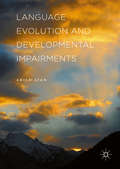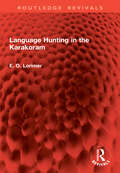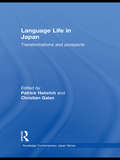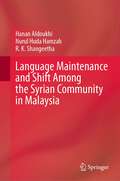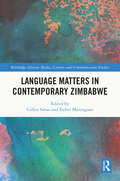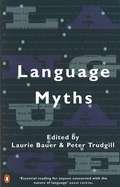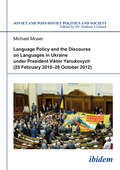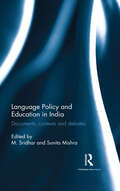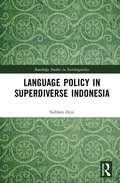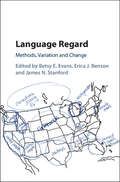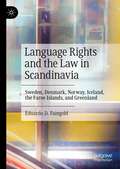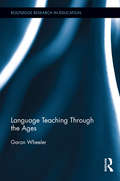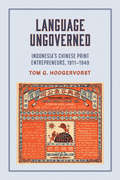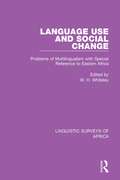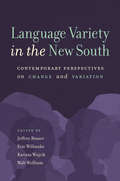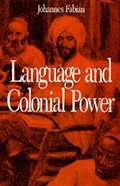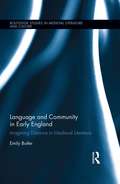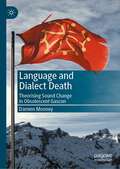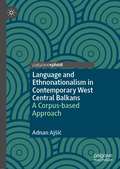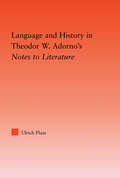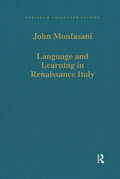- Table View
- List View
Language Evolution and Developmental Impairments
by Arild LianThis book gives an account of developmental language impairment from the perspective of language evolution. Components of language acquisition and specific language impairments can be mapped to stages in the evolutionary trajectory of language. Lian argues that the learning of procedural skills by early ancestors has served as pre-adaptation of grammar. The evolutionary perspective gives rise to a re-evaluation of developmental impairment with respect to diagnostic terminology and methods of treatment. Chapters within cover topics such as dyslexia, the cultural mediation of language evolution and the cross-modality of language. Turn-taking in marmoset monkeys is considered as a pre-adaptation to dialogue in humans, and the role of infant-caregiver interactions is discussed. Language Evolution and Developmental Impairments will be of interest to linguists, psychologists and neurobiologists interested in the intersection of these subjects, as well as scholars of language acquisition and language impairment.
Language Hunting in the Karakoram (Routledge Revivals)
by E. O. LorimerFirst published in 1939, Language Hunting in the Karakoram describes the journey taken by the author to the regions of Gilgit-Baltistan, Kashmir, and Karakoram, and details the author’s experiences when she resided in Hunza with her husband, Lieutenant-Colonel D. L. Lorimer, while he was investigating the Burushaski language. It gives an account of the author’s day-to-day experiences during her stay for fourteen months in 1934–35, and her impressions of the Hunzukuts and their culture, whom she describes as hospitable and delightful people. The book contains excellent photographic plates.
Language Learning and Teaching in Missionary and Colonial Contexts: L'apprentissage et l'enseignement des langues en contextes missionnaire et colonial (Languages and Culture in History)
by Dan Savatovsky Mariangela Albano Thị Kiều Ly Phạm Valérie SpaëthThis volume assembles texts dedicated to the linguistic and educational aspects of missionary and colonial enterprises, taking into account all continents and with an extended diachronic perspective (15th–20th centuries). Strictly speaking, this “linguistics” is contemporary to the colonial era, so it is primarily the work of missionaries of Catholic orders and Protestant societies. It can also belong to a retrospective outlook, following decolonization. In the first category, one mostly finds transcription, translation, and grammatization practices (typically, the production of dictionaries and grammar books). In the second category, one finds in addition descriptions of language use, of situations of diglossia, and of contact between languages. Within this framework, the volume focuses on educational and linguistic policies, language teaching and learning, and the didactics that were associated with them.
Language Life in Japan: Transformations and Prospects (Routledge Contemporary Japan Series)
by Patrick HeinrichDespite its monolingual self-image, Japan is multilingual and growing more so due to indigenous minority language revitalization and as an effect of migration. Besides Japan's autochthonous languages such as the Ainu and Ryukyuan languages, there are more than 75,000 immigrant children in the Japanese public education system alone who came to Japan in the 1980s and who speak more than a hundred different languages. Added to this growing linguistic diversity, the importance of English as the language of international communication in business and science especially is hotly debated. This book analyses how this linguistic diversity, and indeed recognition of this phenomenon, presents a wide range of sociolinguistic challenges and opportunities in fundamental institutions such as schools, in cultural patterns and in social behaviours and attitudes. This topic is an important one as Japan fights to re-establish itself in the new world order and will be of interest to all those who are concerned language change, language versus dialect, the effect of modern technology on language usage, and the way national and social problems are always reflected through the prism of language.
Language Maintenance and Shift Among the Syrian Community in Malaysia
by Hanan Aldoukhi Nurul Huda Hamzah R. K. ShangeethaThis book investigates language choices in different domains among Syrian Arab Muslim families who came to Malaysia after war broke out in their country. It focuses on how Syrian Heritage Language (HL), Modern Standard Arabic (MSA), Classical Arabic (CA), and other languages that might be spoken by these families were maintained and/or shifted from the time these families came to Malaysia until the lockdown due to the COVID-19 pandemic. Most works on Syrian community in Malaysia are focused on social and humanitarian issues; none has explored how Syrians in Malaysia are managing their language use in connection with day-to-day communication and integration. As the Syrian community in Malaysia adapts by learning the host language, their mother language/s might experience a shift. The way the minority communities view their mother language by prioritizing or deprioritizing its use in the family milieu are factors that contribute to language maintenance and language shift (LMLS). As such, this book provides insights on how Syrian parents are managing their own and their children’s language/s, along with the language of the host country.
Language Matters in Contemporary Zimbabwe (Routledge African Media, Culture and Communication Studies)
by Esther Mavengano Collen SabaoSpeaking to a broader global preoccupation with the state of languages and language development, this book considers issues surrounding the diverse languages, linguistic communities, and cultures of Zimbabwe.Reflecting on Shona, Xitsonga, Sotho, Xhosa, Tjwao, Nambya, IsiNdebele, Nyanja, Tshivenda, English and Braille, the book uncovers both the internal and external factors that impact language structures, language use and language ideologies across the country. The book considers how colonial legacies and contemporary language domination and minoritisation have led to language endangerment. It considers the fate of communities whose languages are marginalised and, in the process, poses questions on what can and should be done to preserve Zimbabwean languages. The authors' offerings range across subjects as diverse as music, linguistic innovation, education, human rights, literature, language politics and language policy, in order to build a rich and nuanced picture of language matters in the country.Coming at a critical moment of increasing mobility, migration, cultural plurality and globalisation, this book will be an important resource for researchers across African literature, linguistics, communication, policy and politics.
Language Myths
by Laurie BauerA unique collection of original essays by 21 of the world's leading linguists. The topics discussed focus on some of the most popular myths about language: The Media Are Ruining English; Children Can't Speak or Write Properly Anymore; America is Ruining the English Language. The tone is lively and entertaining throughout and there are cartoons from Doonesbury andThe Wizard of Id to illustrate some of the points. The book should have a wide readership not only amongst students who want to read leading linguists writing about popular misconceptions but also amongst the large number of people who enjoy reading about language in general.
Language Policy and Discourse on Languages in Ukraine Under President Viktor Yanukovych
by Michael MoserDeclared the country's official language in 1996, Ukrainian has weathered constant challenges by post-Soviet political forces promoting Russian. Michael Moser provides the definitive account of the policies and ethno-political dynamics underlying this unique cultural struggle.
Language Policy and Discourse on Languages in Ukraine Under President Viktor Yanukovych: (25 February 2010–28 October 2012) (Soviet and Post-Soviet Politics and Society #122)
by Michael MoserDeclared the country's official language in 1996, Ukrainian has weathered constant challenges by post-Soviet political forces promoting Russian. Michael Moser provides the definitive account of the policies and ethno-political dynamics underlying this unique cultural struggle.
Language Policy and Education in India: Documents, contexts and debates
by M. Sridhar Sunita MishraThis book presents a history of English and development of language education in modern India. It explores the role of language in colonial attempts to establish hegemony, the play of power, and the anxieties in the nineteenth- and early-twentieth-century India. The essays in the volume discuss language policy, debates and pedagogy as well as larger overarching questions such as identity, nationhood and sub-nationhood. The work also looks at the socio-cultural and economic factors that shaped the writing and publishing of textbooks, dictionaries and determined the direction of language teaching, specifically, of English language teaching. Drawing on a variety of archival sources — policy documents, books, periodicals — this book will be of great interest to scholars and researchers of linguistics, language teaching, cultural studies and modern Indian history.
Language Policy in Superdiverse Indonesia (Routledge Studies in Sociolinguistics)
by Subhan ZeinIndonesia has an extreme diversity of linguistic wealth, with 707 languages by one count, or 731 languages and more than 1,100 dialects in another estimate, spoken by more than 600 ethnicities spread across 17,504 islands in the archipelago. Smaller, locally used indigenous languages jostle for survival alongside Indonesian, which is the national language, regional lingua francas, major indigenous languages, heritage languages, sign languages and world languages such as English, Arabic and Mandarin, not to mention emerging linguistic varieties and practices of language mixing. How does the government manage these languages in different domains such as education, the media, the workplace and the public while balancing concerns over language endangerment and the need for participation in the global community? Subhan Zein asserts that superdiversity is the key to understanding and assessing these intricate issues and their complicated, contested and innovative responses in the complex, dynamic and polycentric sociolinguistic landscape of Indonesia that he conceptualises as superglossia. This offers an opportunity for us to delve more deeply into such a context through the language and superdiversity perspective that is in ascendancy. Zein examines emerging themes that have been dominating language policy discourse including status, prestige, corpus, acquisition, cultivation, language shift and endangerment, revitalisation, linguistic genocide and imperialism, multilingual education, personnel policy, translanguaging, family language policy and global English. These topical areas are critically discussed in an integrated manner against Indonesia’s elaborate socio-cultural, political and religious backdrop as well as the implementation of regional autonomy. In doing so, Zein identifies strategies for language policy to help inform scholarship and policymaking while providing a frame of reference for the adoption of the superdiversity perspective on polity-specific language policy in other parts of the world.
Language Regard
by Betsy E. Evans Erica J. Benson James N. Stanford"Bringing together a team of renowned international scholars, this volume provides a wide-ranging collection of historical and state-of-the-art perspectives on language regard, particularly in the context of language variation and language change, and importantly, highlights the range of new methodologies being used by linguists to explore and evaluate it. The importance of language regard to the inquiry of language variation and change in the field of sociolinguistics is increasingly being recognized, yet misunderstandings about its nature and importance continue to exist. This volume provides scholars and students of sociolinguistics, with the tools and theory to pursue such inquiry. Contributions and research come from Europe, North America, and Asia, and language varieties such as Spanish, Dutch, Danish, and American Sign Language are discussed"--
Language Rights and the Law in Scandinavia: Sweden, Denmark, Norway, Iceland, the Faroe Islands, and Greenland
by Eduardo D. FaingoldThis book examines the language policies in the constitutions, legal statutes, and regulations of Sweden, Denmark, Norway, Iceland, the Faroe Islands, and Greenland. In these countries and territories, modern descendants of Old Norse (North Germanic) are spoken today: Swedish, Danish, Norwegian, Icelandic, and Faroese. In addition, there are regions of Scandinavia where speakers of minority languages were conquered or incorporated, with their languages suppressed or neglected, as well as recent developments in the status and use of English, and immigrant populations who do not speak a Scandinavian language as their native language. This book adopts a comparative approach to trace the development of language policies and rights in Scandinavia, and it will be of interest to students as well as scholars of European and Scandinavian studies, applied linguistics, sociolinguistics, education, political science, and law.
Language Teaching Through the Ages (Routledge Research in Education #93)
by Garon WheelerKonrad Koerner, a leading historian of linguistics, has long said that an academic field cannot be considered to have matured until it has history as one of its subfields. The history of linguistics is a growing area, having come into its own in the 1960s, especially after Noam Chomsky looked for historical roots for his work. In contrast, the history of language teaching has been neglected, reflecting the insecurity and youth of the field. Most works on the subject have been written by linguists for other linguists, and typically focus on a specific period or aspect of history. This volume concentrates on the basic issues, events, and threads of the history of the field - from Mesopotamia to the present - showing how a knowledge of this history can inform the practice of language teaching in the present.
Language Ungoverned: Indonesia's Chinese Print Entrepreneurs, 1911–1949
by Tom G. HoogervorstBy exploring a rich array of Malay texts from novels and newspapers to poems and plays, Tom G. Hoogervorst's Language Ungoverned examines how the Malay of the Chinese-Indonesian community defied linguistic and political governance under Dutch colonial rule, offering a fresh perspective on the subversive role of language in colonial power relations. As a liminal colonial population, the ethnic Chinese in Indonesia resorted to the press for their education, legal and medical advice, conflict resolution, and entertainment. Hoogervorst deftly depicts how the linguistic choices made by these print entrepreneurs brought Chinese-inflected Malay to the fore as the language of popular culture and everyday life, subverting the official Malay of the Dutch authorities. Through his readings of Sino-Malay print culture published between the 1910s and 1940s, Hoogervorst highlights the inherent value of this vernacular Malay as a language of the people.
Language Use and Social Change: Problems of Multilingualism with Special Reference to Eastern Africa (Linguistic Surveys of Africa #22)
by W. H. WhiteleyThe social implications of multilingualism is a field of study on whcih systematic research began only in the second half of the 20th century in Africa. This book, originally published in 1971, contains papers which concentrate on East Africa but it also discusses theoretical problems and methods arising from socio-linguistic studies outside the African field. These include studies on national languages and languages of wider communication in developing nations; the communication role of languages in multilingual societies; and social and cognitive aspects of bilingualism.
Language Variety in the New South: Contemporary Perspectives on Change and Variation
by Jeffrey Reaser, Eric Wilbanks, Karissa Wojcik, Walt WolframBringing together scholars from a range of disciplines to assess the use and meaning of language in the South, a region rich in dialects and variants, this comprehensive edited collection reflects the cutting-edge research presented at the fourth decennial meeting of Language Variety in the South in 2014. Focusing on the ongoing changes and surprising continuities associated with the contemporary South, the contributors use innovative methodologies to pave new pathways for understanding the social dynamics that shape the language in the South today.Along with the editors, contributors to the volume include Agnes Bolonyai, Katie Carmichael, Phillip M. Carter, Becky Childs, Danica Cullinan, Nathalie Dajko, Catherine Evans Davies, Robin Dodsworth, Hartwell S. Francis, Kirk Hazen, Anne H. Charity Hudley, Neal Hutcheson, Alex Hyler, Mary Kohn, Christian Koops, William A. Kretzschmar Jr., Sonja L. Lanehart, Andrew Lynch, Ayesha M. Malik, Christine Mallinson, Jim Michnowicz, Caroline Myrick, Michael D. Picone, Dennis R. Preston, Paul E. Reed, Joel Schneier, James Shepherd, Erik R. Thomas, Sonya Trawick, and Tracey L. Weldon.
Language and Colonial Power: The Appropriation of Swahili in the Former Belgian Congo, 1880-1938
by Johannes FabianAmong the preconditions for establishing colonial authority was communication with the colonised. Verbal exchanges depended on a shared communicative praxis providing common ground on which unilateral claims could be imposed. Use of, and control over, verbal means of communication were needed to maintain regimes - military, religious-ideological, economic - in power. In the Belgian Congo brutal physical force never ceased to be exercised. In this study Professor Fabian examines the more subtle uses of power through controls on communication, by looking at the history of Swahili as it spread from the East Coast to Central Africa and demonstrating connections between -changing forms of colonial power and the development of policies towards Swahili. Using a wide range of sources, including numerous and sometimes obscure vocabularies, he combines concepts derived from literary theory and sociolinguistics to uncover, through the flaws and failures of these texts, deep-seated attitudes to language and communication.
Language and Community in Early England: Imagining Distance in Medieval Literature
by Emily ButlerThis book examines the development of English as a written vernacular and identifies that development as a process of community building that occurred in a multilingual context. Moving through the eighth century to the thirteenth century, and finally to the sixteenth-century antiquarians who collected medieval manuscripts, it suggests that this important period in the history of English can only be understood if we loosen our insistence on a sharp divide between Old and Middle English and place the textuality of this period in the framework of a multilingual matrix. The book examines a wide range of materials, including the works of Bede, the Alfredian circle, and Wulfstan, as well as the mid-eleventh-century Encomium Emmae Reginae, the Tremulous Hand of Worcester, the Ancrene Wisse, and Matthew Parker’s study of Old English manuscripts. Engaging foundational theories of textual community and intellectual community, this book provides a crucial link with linguistic distance. Perceptions of distance, whether between English and other languages or between different forms of English, are fundamental to the formation of textual community, since the awareness of shared language that can shape or reinforce a sense of communal identity only has meaning by contrast with other languages or varieties. The book argues that the precocious rise of English as a written vernacular has its basis in precisely these communal negotiations of linguistic distance, the effects of which were still playing out in the religious and political upheavals of the sixteenth century. Ultimately, the book argues that the tension of linguistic distance provides the necessary energy for the community-building activities of annotation and glossing, translation, compilation, and other uses of texts and manuscripts. This will be an important volume for literary scholars of the medieval period, and those working on the early modern period, both on literary topics and on historical studies of English nationalism. It will also appeal to those with interests in sociolinguistics, history of the English language, and medieval religious history.
Language and Complex Systems
by William A. Kretzschmar Jr.An understanding of language as a complex system helps us to think differently about linguistics, and helps us to address the impact of linguistic interaction. This book demonstrates how the science of complex systems changes every area of linguistics: how to make a grammar, how to think about the history of language, how language works in the brain, and how it works in social settings. Kretzschmar argues that to construct the best grammars of languages it is necessary to understand the complex system of speech. Each chapter makes specific recommendations for how linguists should manage empirical data in order to form better generalizations about a language and its varieties. The book will be welcomed by students and scholars working in linguistics and English language, especially the study of language variation and the historical development of English.
Language and Dialect Death: Theorising Sound Change in Obsolescent Gascon
by Damien MooneyThis book offers a systematic acoustic phonetic analysis of both language and dialect death in the region of Béarn, southwestern France. Focusing on Béarnais, a localised dialect of Gascon which is under pressure from French, the author explores the socio-political process of language shift, whereby members of a speech community cease to speak their indigenous language in favour of an incoming dominant language. Gascon is at an advanced stage of this process, making its remaining speakers excellent candidates for the study of language obsolescence, and this unique study will be of interest to researchers working in a broad range of disciplines, including language variation and change, language and dialect contact, Occitan and French, sociophonetics and phonology.
Language and Ethnonationalism in Contemporary West Central Balkans: A Corpus-based Approach
by Adnan AjšićThis book uses a specialized corpus of public language-related discourse to investigate links between language ideologies and ethnonationalism in contemporary West Central Balkans. Despite a century and a half of shared linguistic history, the nations making up the central part of former Yugoslavia continue to debate the ownership over the common language, creating much animosity, some legal issues, and often absurd circumstances. At the heart of the ongoing language debate over Central South Slavic is the belief in language as the cornerstone of ethnonational identity and the legitimacy of ethnic groups’ claims to sovereignty. Given a history of conflict and the recent resurgence in extreme ethnonationalism, an understanding of ethnolinguistic contestation in the region is as important as ever. This book will be of interest to social scientists working in fields as diverse as (applied) linguistics, anthropology, media studies, political science, sociology and history, as well as other scholars with an interest in language and society.
Language and History in Adorno's Notes to Literature (Studies In Philosophy Ser.)
by Ulrich PlassLanguage and History in Theodor W. Adorno's Notes to Literature explores Adorno’s essays on literature as an independent contribution to his aesthetics with an emphasis on his theory and practice of literary interpretation. Essential to Adorno’s essays is his unorthodox treatment of language and history and his elaboration of the links between the two. One of Adorno’s major but often-neglected claims is that truth is relative to its historical medium, language. Adorno persistently and creatively tries to narrow the gulf between truth and expression, philosophy and rhetoric, and his essays on literature are practical examples of his effort to critically rescue the rhetorical dimension of philosophy. Rather than relying exclusively on aesthetic concepts inherited from his predecessors in the Western tradition (Kant, Hegel, Nietzsche, Kierkegaard), Adorno’s essays seek to transgress and transcend the conceptual limitations of aesthetic discourse by appropriating a non-conceptual, metaphorical vocabulary borrowed from the literary texts he investigates. Thus, Adorno’s interpretations of literature mobilize an alternative subterranean, primarily essayistic and fragmentary discourse on language and history that eludes the categories that tend to predominate his thinking in his major work, Aesthetic Theory. This book puts forth the claim that Adorno’s essays on literature are of central relevance for an understanding of his aesthetics because they challenge the conceptual limitations of philosophical discourse.
Language and History: Integrationist Perspectives (Routledge Advances in Communication and Linguistic Theory #Vol. 4)
by Nigel LoveWhen linguistics was first established as an academic discipline in the nineteenth century, it was envisaged as an essentially historical study. Languages were to be treated as historical objects, evolving through gradual but constant processes of change over long periods of time. In recent years, however, there has been much discussion by historians of a 'linguistic turn' in their own discipline, and, in linguistics, integrationist theory has mounted a radical challenge to the traditional notion of 'languages' as possible objects of inquiry.Language and History develops the integrationist critique of orthodox linguistics, while at the same time extending its implications to the field of history. By doing so, it throws light on what is now recognized by many historians to be a 'crisis' in their own discipline. Underlying the post-modernist scepticism about traditional forms of historiography, the integrationist approach reveals a more deep-seated problem concerning the interface between philosophy of history and philosophy of language. With chapters from a range of leading international contributors, Language and History represents a significant contribution to the developing work of the integrationists.
Language and Learning in Renaissance Italy: Selected Articles (Variorum Collected Studies)
by John MonfasaniLanguage was the Italian humanists’ stock-in-trade, rhetoric their core discipline. In this volume Professor Monfasani collects together his most important articles on these subjects. One group of these, including two review essays, focuses specifically on the humanist Lorenzo Valla and on his philosophy of language. The third section of the book opens out the coverage of Italian Renaissance cultural history and includes studies of several new texts - among them a description of the decoration of the Sistine Chapel, and a call for press censorship - and of the religious culture of mid-15th-century Rome. Le langage était l’instrumet de base des humanistes italiens, la rhétorique leur discipline de fond. Dans ce volume, le professeur Monfasani rassemble ses articles les plus importants sur le sujet . Un groupe d’entre eux, comprenant deux comptesrendus, se concentre spécifiquement sur l’humaniste Lorenzo Valla et sur sa philosophie du langage. La troisième section du recueil élargit le champ de connaissance de l’histoire culturelle de la Renaissance italienne et inclus des études de plusieurs textes nouveaus - parmi ceux-ci, une description de la décoration intérieure de la chapelle Sixtine et un appel à la censure de la presse -, ainsi que de la culture religieuse romaine au milieu du 15e siècle.
